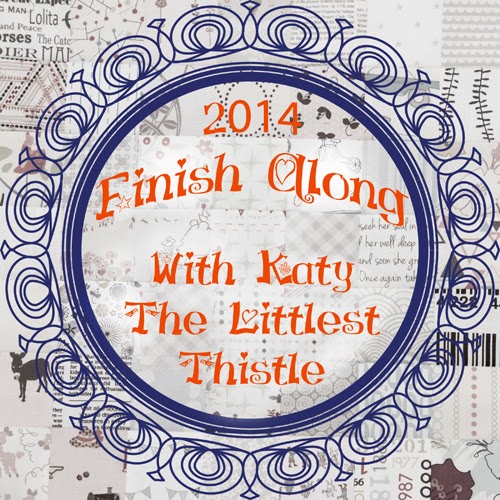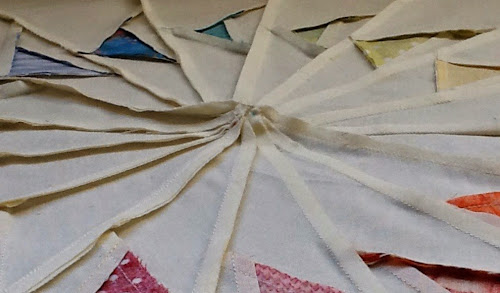I've written this post with my bee-mates in the BuzzyFriendsQuiltingBee in mind, so it may be very wordy and picture heavy!
I've had Anna Maria Horners' Feather Bed pattern on my never-ending wish list for quite a while, so it seemed the perfect choice for my month in the bee.I'm going to try and include everything I did when making my practice block, some of which is probably very basic information, which you may not need, but as I'm trying to be thorough I don't want to miss anything out.
Printing out the pattern.
Genourously, Anna Maria Horner offers this as a free pattern on her website, click here for the link.
Just a note of caution - when you come to print out check which size option you choose '. I used 'actual size' in the print option. My pattern came out as 18 1/2 inches along the outside edge of the (F1 +F2) template piece when assembled (about 46.5 cm). This means my finished block, comprising two feathers, finishes at eighteen and a half inches square
I found it helpful to leave a bit of spare paper at the join of the F1 and F2 pieces (see middle picture) which meant I could stick one piece on top of the other and made the join a bit stronger, which is useful if it will be handled a lot.
Before you do anything else I suggest you read through the pattern. It is well written and covers everything you need to know.
Selecting and cutting the fabric.
For the Feathers.
I've chosen mostly quite strong saturated colours with a few lighter prints. I've also tried to mix up prints and plains, spots and checks, large and small scale pattern. This project is perfect for using up lots of scraps!
Choose your fabrics, cutting off strips as specified in the pattern (between 1 1/2 and 3 inches wide). Once you have cut your strips, you'll need to lay them out in an order you like. I prefer to have a bit of contrast between the strips, either by pattern or colour.
Piecing and pressing the feathers.
You can piece the strips together straight away in a 'all the ends level' arrangement as above or you can 'stagger' the ends to minimise wastage, which is what I did. To do that, lay out your strips and lay the feather piece over it, lining up the 'direction' lines parallel with the long edges. It's probably easier to see what I mean in the picture below.
When you are happy with your fabric placement pin the strips in pairs, being careful to keep the 'stagger' and sew together.
Carefully press the seams open, a lot of distortion can be introduced at this point if you don't press carefully.
Lay the strips out again to work out the stagger between the pairs, laying the template on top to make sure you are happy with the placement. Pin, sew, press, repeat as necessary until you achieve the size of pieced fabric panel you need.
Pin your template to the pieced panel - I found the fabric moved quite a bit, especially when cutting at the points and even more if there was a seam very close to the point of the feather.
These round headed pins aren't the best idea when you want to use a ruler over them!
NOTE - you must be aware of the alignment marks on the template pieces, do not just place the template against the cut edge of the fabric panel.
It is not possible to cut the left and right halves of the feather from a single pieced panel with this method. Anna Maria Horner describes a way to cut both left and right halves of the feather from a single large panel in her directions, which you may find useful.
Cutting the background fabric.
I have chosen to use yarn-dyed Essex linen (45% linen 55% cotton) as the background for my quilt. This fabric has a beautiful drape and is heavier than quilting weight cotton.
Essex linen is especially easy to use with this pattern as it does not have a 'right' side. Meaning there is less chance of error when cutting out the background pieces.
As I would need to send a piece of background fabric to each member of the Hive I needed to work out the most efficient way to lay out the templates on a single piece of fabric. I found this process easier if I made templates for each piece and laid them out on a single piece of fabric as shown. As I would need to send a piece of background fabric to each member of the Hive I needed to work out the most efficient way to lay out the templates on a single piece of fabric. I found this process easier if I made templates for each piece and laid them out on a single piece of fabric as shown below.
As I would need to send a piece of background fabric to each member of the Hive I needed to work out the most efficient way to lay out the templates on a single piece of fabric. I found this process easier if I made templates for each piece and laid them out on a single piece of fabric as shown below.
The fabric is sub cut as shown, to give two pieces of 18 and a half inches by six and a quarter inchesA piece of fabric 22 inches by 16 and a half inches is enough to make the background for one complete block of two feathers.
Lay an F template piece on one of these 181/2 by 6 1/4 rectangles, pin and cut. This gives you two F pieces. Repeat with the other rectangle (if using printed fabric, turn the template over, to give the reversed F piece for the other side of the feather).
Cutting the F pieces by this method helps to keep the outside edge straight along the grain of the fabric.
The B, D and E pieces are cut from the remaining fabric.
I
Before piecing together, I laid out my background pieces;
Taking the left side feather and B piece, lay them next to each other to make sure you have the correct piece and that they are the correct size.
Flip the background piece up and align the edges of the fabric. The ends need to overlap slightly, as shown below, in order for the pieces to align correctly once they are sewn together.
The pencil line represents the edge of the fabric, I have drawn a red dashed line a quarter of an inch from the fabric edge to show where the fabric will be stitched.
The needle should enter the fabric exactly at the 'V' formed where the two fabrics overlap and leave at the same place at the other end, as shown below.
When opened out the straight edges of the feather and background fabrics should form a continuous line. (Obviously, this doesn't happen exactly like this every time, which is why I own more than one seam ripper.)
Press the seams open and clip the dog ears. Repeat with the other side.
Sewing the spine of the feather - the C piece.
I found that this piece, probably because it is so long and thin, moved quite a bit relative to the other pieces.
I pinned quite extensively and on both sides I started sewing at the bottom of the block.
There is a little bit of wiggle room, in that you can trim a small amount from the top of the feather if needed without affecting the overall dimensions of the block.
Sewing the top of the feather - the D and E piece
Firstly, trim the feather to remove the excess 'spine, that protrudes past the edge. Then align the D piece next to the feather. I'll admit the first time I did this it looked 'wrong' for some reason. This is what it should look like;
Then flip the piece over and line it up with the edge of the feather.
When you open it out after stitching, it should look like this.




















































